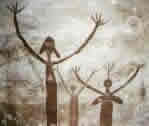| |
A
succession of visiting spacecraft have left little doubt:
Mars is a frozen ball of arid desert, its thin atmosphere made
up almost entirely from unbreathable carbon dioxide. It seems
to be no place for living things. But the Red Planet used to be
different. Billions of years ago, water flowed on a much warmer
surface. Life may have come to Mars, possibly even before it arose
on the Earth. And as we know from Earth, life is tenacious. So
despite the evidence so far, this apparently sterile planet might
still be alive.
|
| Red
Not Dead |
Until
the first planetary probes of the space age relayed their observations,
many astronomers were sure that life thrived on Mars. The planet's
seasonal color changes were put down to the summer growth of vegetation,
and there were more arguments about the nature of Martian plants
than about their existence.
|
But
the Mariner flybys in 1971 and the Viking landers in 1976 changed
all that. Mariner 9 revealed Mars to be cold and arid, scorched
by ultraviolet radiation—and sterile. Experiments carried
out by the Vikings appeared to confirm the lifelessness of the
Martian soil: The Red Planet was almost as desolate as the Moon.
|
But
as the data was assessed, scientists came to believe that Mars
was once a very different place. All over the planet were gullies
and eroded channels—signs that water had once flowed. Strewn
boulders on the Martian plains resembled flood debris on Earth.
And the shape and structure of some of the Martian craters suggested
that incoming meteorites may have struck wet ground— a Martian
swamp, or perhaps even a shallow ocean.
|
For
liquid water to have existed on Mars' surface, the planet must
have been much warmer than it is today, and its atmosphere much
thicker. Four billion years ago, just 500 million years after
the formation of the solar system, the Martian environment could
have been just right for the evolution of life. Conditions on
Mars would certainly have been better than they were on Earth
at the | same time: Mars is much smaller than the Earth, and almost
50 million miles farther from the Sun, so it would have cooled
more quickly from its original molten state.
|
| If
Life Evolved |
Early
Martian life, if it existed, may have resembled the living things
that emerged on Earth a few hundred million years later. In warm,
shallow water, organisms akin to blue-green algae on Earth would
have appeared. Gradually they would have spread across Mars' surface,
finding a foothold wherever it was moist and sunlit.
|
Again,
as on Earth, these organisms would have begun the slow process
of altering the atmosphere from a blanket of carbon dioxide to
the oxygen-rich mixture that would fuel more advanced life forms.
But there the two planets' biological histories diverged. On Earth,
the algae dominated for eons before more advanced types of life
evolved: It took more than 3 billion years from the dawn of life
to the arrival of the first complex animals.
|
On
Mars, though, complexity never had the time to evolve. Faster
than life could compensate, the planet began to chill. Much of
its atmosphere was lost to space, and as the core cooled, geological
activity came to an end. One by one, the great volcanoes whose
outgassing might have replenished the thinning air sputtered into
extinction. The age of liquid water came to an end.
|
Probably,
any Martian life ended with it. But it could not all have died
at once. Forever seeking warmth and wetness, Martian organisms
would have retreated into the deep valleys where a little water
still remained,or into hot springs around the dying volcanoes.
The battle for survival would have been fought on a microscopic
scale, but it was still an epic—and life may not have lost.
|
Against
the relentless transformation of the planet's environment, life
had only one weapon. But it was a powerful one: the ability to
adapt. The volcanoes died slowly—some were still active less
than a billion years ago—and Martian organisms may have had
a chance to carve themselves a new niche. Certainly, their descendants
would have been bred for toughness. Deep inside the planet, in
a few favored locations, they might still be hanging on.
|
|
|

|
|
|
|


| COLDER
CLIMATE |
| Since
the visits of the Viking landers in 1976, the average temperature
on Mars has dropped by 36°F. On Earth, such a change would
mean a catastrophic ice age. |


| MARTIAL
ART |
| Many
Victorian astronomers thought Mars had intelligent inhabitants.
They often referred to these creatures as "Martials/ though,
not Martians. |

| MARTIAN
SPEAK |
| In
1896, psychic Helene Smith had visions of Mars and learned to
speak Martian—a language that turned out to be very similar
to French. |
|
|




